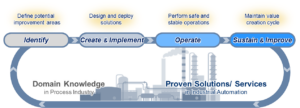Synaptic Business Automation – Value Creation Cycle
Everything has a life cycle. For example, the seasons in nature, a product in a company, an industry in the economy, job profiles in professional life or my house in the real estate market. Once I bought it as a dream house, I have to modernise it again and again.
Only who or what reinvents itself again and again will be successful. This circumstance very often depends on many and unpredictable environment variables. And with exactly this insight I came back to my desk highly motivated a few years ago from my marketing studies. Since then I have repeatedly encountered examples from the past and present, which show me that everyone should deal with it. This situation is accelerated with increasing innovative strength.
 From horse to automobile
From horse to automobile
The world is changing and new trends, technologies and business models will continue to prevail. Let us reflect this in terms of people’s mobility needs and associated behaviour over the past 100 years or so. In this respect, it is a market that has constantly reinvented itself. One that is still constantly changing today and will continue to develop new technologies and models for the future.
The horse and the carriages were long regarded as the mobility concept par excellence. This view changed very quickly at the beginning of the 20th century, although the innovation cycles of that time were considerably slower than today. “The future belongs to horses” – declared Kaiser Wilhelm at the beginning of the 20th century. Only 15 years later there was almost no horse traffic in German cities.
The breakthrough of new technologies and products is always driven by economic efficiency and benefits. Henry Ford made the car possible for everyone through assembly line work. Although there was still no infrastructure such as roads, petrol stations and refineries, the breakthrough of the car could not be stopped. The benefits were high and the acquisition costs slipped through the innovation in production into an area that ensured that the medium-sized businesses could afford a car. The success also brought new challenges. New production concepts (Just in Time / Just in Sequence), but also new business models such as renting, financing and leasing were introduced to the market time and again in addition to the purchase of the car.
Driven industry
Now the mobility industry is once again facing a challenge. Driven by environmental and safety requirements and the higher and changing mobility requirements including infrastructure tasks, the market will reposition itself. This means that it will again generate new business models (sharing), but also technologies (electricity, hybrid, gas). And here too, the discussion about a lack of infrastructure and economic efficiency will not stop the change. There are already sharing concepts today that offer mobility for 19 cents per kilometre.
Now this phenomenon has also reached process automation, in which I have been active for over 17 years. This has always been known as conservative. And also rather than sluggish when it comes to adapting new technologies. A good example here is the cumbersome integration and project management of fieldbus at the beginning of the 2000s. This was probably just an attempt to implement digitization in the process industry.
The process industry is also constantly confronted with new challenges. Influenced by raw material prices, ever shorter product life cycles and quality and driven by the consumer market, urbanization (in 2030 about 60% of people will live in metropolises) as well as globalization and the convergence of markets. This offers new solutions combined from proven OT (Operational Technology) and IT (Information Technology). This is to optimize production plants, to make them more resilient to these challenges and to establish new business models. Just comparable with the mobility market already mentioned.
New applications

Back to the future
The introduction of decentralized process control systems in the mid-1970s significantly changed automation concepts and project management. At the same time, however, it also increased productivity, transparency and safety.
I claim that the digital transformation, which will move into process automation via NAMUR open architecture, modular automation and mobile maintenance concepts, will have a greater change in automation concepts and project management than the process control systems introduced some 40 years ago. Who and how determines the requirements will in future draw up the specifications if technology and business cycles are shorter than the traditional project duration.
Requirements similar to a nervous system
We at Yokogawa have also been working intensively on this change for a long time. We have defined our strategy in the form of Synaptic Business Automation (SBA). In this way, we want to implement the digital transformation in a user-oriented manner with our customers in the process industry in a timely manner.
The similar requirements that a nervous system fulfils through its ad-hoc learning ability and the creation of new links will be placed on automation today and in the future. Precisely in order to follow these ever faster changes in process automation.
A core element of Synaptic Business Automation is the Value Creation Cycle, with the help of which we implement this new project form together with the plant operator.
We have implemented four steps for this:
- Identify – record and advise
- Create & Implement – plan and implement
- Operate – operate and optimize
- Sustain & Improve – maintain and supplement
Especially at the beginning of a project we can help operators to realistically assess their initial situation and plan promising steps together with them. For optimization, migration, modernization or transformation. In this way, “synaptic” values can arise directly from operator knowledge and automation expertise.
Expertise greatly expanded
In addition to this method as a core element, SBA offers much more. We have greatly expanded our expertise outside classical automation technology through M&A with KBC (Consulting & Simulations), Industrial Knowledge (Cloud Services) and Soteica (Energy Management). A flexible execution framework, which supports both waterfall and agile SCRUM project processing, guarantees that we also implement this in practice as required. Ultimately, we provide the customer with a usable value with each sub-step (sprint).
Continuous further development in the areas of portfolio, products, solutions, services and technologies and their use in SBA ensure that they are up to date for the customer.
Even a successful traditional company like Yokogawa has to face the challenges in order to cope with the changes. To remain in the image drawn at the beginning: With SBA, we ensure that we are not a coachbuilder in the process industry, but rather provide solutions that (as mentioned above in the example) are geared to the changes in demand, infrastructure, technology and business models in the process industry.
How do you meet the constantly changing requirements in the process industry?
And what changes can they even feel?
I would like to invite you to discuss these and other exciting questions with me here on the blog.
Synaptic Business Automation als Leitthema bei der ACHEMA 2018


 From horse to automobile
From horse to automobile


